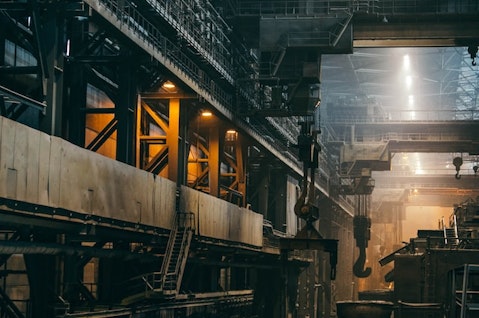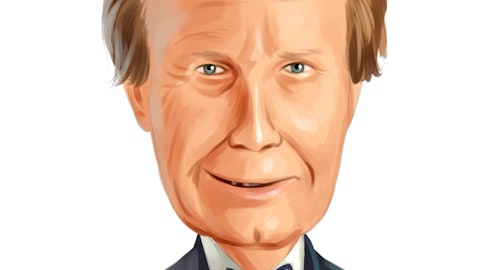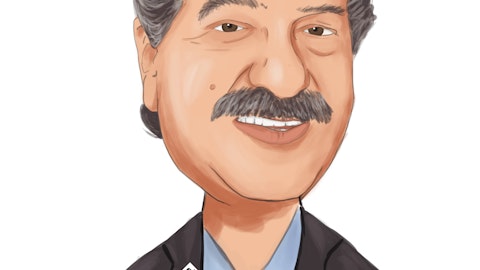Reliance Steel & Aluminum Co. (NYSE:RS) Q4 2022 Earnings Call Transcript February 16, 2023
Operator: Greetings. And welcome to the Reliance Steel & Aluminum Company’s Fourth Quarter 2022 Earnings Conference Call. At this time, all participants are in a listen-only mode. A question-and-answer session will follow the formal presentation. As a reminder, this conference is being recorded. I would now like to turn the conference over to your host, Kim Orlando, with ADDO Investor Relations.
Kim Orlando: Thank you, Operator. Good morning. And thanks to all of you for joining our conference call to discuss Reliance’s fourth quarter and full year 2022 financial results. I am joined by Karla Lewis, President and Chief Executive Officer; Steve Koch, Executive Vice President and Chief Operating Officer; and Arthur Ajemyan, Senior Vice President and Chief Financial Officer. A recording of this call will be posted on the Investors section of our website at investor.rsac.com. The press release and the information on this call may contain certain forward-looking statements which are based on a number of assumptions that are subject to change and involve known and unknown risks, uncertainties or other factors, including the impacts of inflation, geopolitics and the COVID-19 pandemic and related economic conditions on our future operations, which may not be under the company’s control and may cause the actual results, performance or achievement of the company to be materially different from the results, performance or other expectations implied by these forward-looking statements.
These factors include, but are not limited to, those factors disclosed in the company’s annual report on Form 10-K for the year ended December 31, 2021 and updated on Form 10-Q for the quarter ended September 30, 2022, under the caption Risk Factors, disclosure in our press release this morning and other documents Reliance files or furnishes with the Securities and Exchange Commission. The press release and the information on this call speak only as of today’s date and the company disclaims any duty to update the information provided therein inherent. I will now turn the call over to Karla Lewis, President and CEO of Reliance.
Karla Lewis: Thanks, Kim. Good morning, everyone. And thank you all for joining us today to discuss our fourth quarter and full year 2022 financial results. Before I begin, I’d like to say that I am honored to have the privilege to serve as CEO of this wonderful family of companies. I look forward to continuing our longstanding track record of industry leading financial operational and safety performance, growing our company and increasing stockholder value in the years ahead. I would also like to acknowledge Jim Hoffman for his significant contributions to Reliance, both during his tenure as CEO and throughout his many years of service to the company. On behalf of the management team here at Reliance, we wish him all the best in his upcoming retirement at the end of the year.
I will begin today with an overview of our 2022 performance and capital allocation strategy. Steve will then speak to our operating results and demand trends by end market. And Arthur will conclude with a review of our fourth quarter 2022 financial results, as well as our outlook for the first quarter of 2023. Turning to our results. We are very pleased to have achieved record financial performance in 2022 across nearly every metric during a period of continued metal price volatility and broader economic uncertainty. Our unique business model is designed to position Reliance as the customer and supplier of choice throughout industry cycles. We are differentiated by the diversity of our operations, superior customer service and ability to generate significant cash to fuel our longstanding commitment to both growth and stockholder returns.
Our full year 2022 net sales were a record $17 billion, driven by solid demand in the majority of our end markets, along with favorable metals pricing. In 2022, more than half of our orders included value-added processing, which when combined with our product and end market diversification and focus on small orders with quick turnaround drove our strong gross profit margin of 30.8% for the year, which was at the high end of our estimated sustainable annual range despite declining prices for most products in the second half of the year. Effective expense management, coupled with our strong gross profit margin supported record annual non-GAAP pre-tax income of $2.44 billion and record non-GAAP diluted earnings per share of $30.03. And let me say that again, record non-GAAP diluted earnings per share of $30.03.
We generated record annual cash flow from operations of $2.12 billion in 2022, far surpassing our prior record of $1.3 billion in 2019, made possible by our record profitability and working capital management. I applaud and thank our team on achieving these outstanding results and for doing so safely with 2022 marking an all-time low for our total recordable incident rate. Our strong cash generation and liquidity enables us to continue executing our disciplined capital allocation strategy with particular emphasis on both growth and stockholder returns. We invested nearly $342 million in capital expenditures in 2022, setting a new annual record with the majority of funding growth opportunities. Our full year 2023 capital expenditure budget is another new record at $500 million, with an expected total cash outlay of approximately $400 million to $450 million in 2023, which includes some carryover from 2022 and prior year projects due to ongoing extended lead times throughout the supply chain.
We anticipate about two-thirds of our budget will be focused on growth initiatives in areas such as facility upgrades and expansions into new markets, new equipment to expand, automate and improve the efficiency of our value-added processing capabilities along with creating safer and improved working environments for our valued employees. Although we did not complete any acquisitions in 2022, the pipeline remains healthy and we continue to evaluate many opportunities with the goal of pursuing those that meet our disciplined criteria. We returned over $847 million to our stockholders in 2022 through dividends and share repurchases. Furthermore, as announced in our earnings release this morning, we were pleased to increase our quarterly cash dividend by 14.3% to $1 per share or $4 on an annualized basis, underscoring our confidence in our long-term strategy and outlook.
Over the last five years, we have allocated nearly $2 billion of capital towards organic growth and acquisitions, and nearly $2.7 billion towards stockholder returns in the form of dividends and share repurchases. Looking ahead, we believe our strong balance sheet and liquidity will enable us to continue executing our capital allocation priorities, no matter the operating environment. In closing, I am extremely pleased with our record setting 2022 performance. These results were achieved in a highly challenging environment with ongoing inflationary headwinds, recessionary concerns, supply chain disruptions, labor shortages and overall declining metal prices in the second half of the year. Our managers in the field have done a tremendous job navigating these challenges, supporting our confidence and our ability to deliver strong performance in the year ahead.
As we move into 2023, we are optimistic the Infrastructure Bill, the CHIPS Act and the Inflation Reduction Act should serve as tailwinds for growth in an environment of sustained higher metal pricing compared to historical levels. I would like to thank everyone at Reliance for their continuing and steadfast commitment to operational excellence and safety. Thank you all for your time today. I will now turn the call over to Steve who will review our fourth quarter operating results and demand trends. Steve?

Photo by Ant Rozetsky on Unsplash
Steve Koch: Thanks, Karla, and good morning, everyone. First, I’d like to congratulate Karla on assuming the role of CEO at Reliance. Karla and I have worked together since 2005 when Chapel Steel was acquired by Reliance and joined the family of companies. Karla is extremely well respected within our organization and throughout the industry and I look forward to working more closely with her going forward. I’d also like to extend a sincere thank you to each member of our team of over 15,000 employees for showing up each day and working diligently and safely to ensure we exceed our customer’s expectations. Our record setting performance in 2022 is also made possible by our customers who count on us for quick deliveries of high quality products at competitive prices, as well as our suppliers have continued to support us through challenging times and supply chain disruptions.
Now I will turn to our fourth quarter pricing and demand trends. Our fourth quarter tons sold declined 8.2% compared to the third quarter of 2022 due to anticipated seasonal declines in line with our expectations of down 6.5% to 8.5% and improved 0.8% from the prior year quarter. Our performance was primarily driven by strong demand in broader manufacturing and non-residential construction, as well as robust aerospace and semiconductor shipments. Similar to the last several quarters, we believe our fourth quarter shipments could have been even stronger had not been for a persistent supply chain related disruptions, including labor shortages at our customer’s facilities. Our fourth quarter average selling price per ton sold of $2,799 declined 7.9% compared to the third quarter of 2022, consistent with our expectation of down 6% to 8%, that remained elevated by historical standards.
Prices for the vast majority of the carbon steel products sold, along with the stainless and aluminum products continued to decline throughout the fourth quarter. However, continued strong demand for higher value products, both at the aerospace, semiconductor and energy markets helped offset some of the downward pricing pressure on our average selling price. We have been seeing signs of stabilization on certain products to date in 2023 as our average selling price per ton overall remained relatively flat in January compared to December. Arthur will cover our first quarter 2023 outlook in more detail. On a non-GAAP FIFO basis, which is how we monitor our day-to-day operating performance, our gross profit margin remained consistent with the prior quarter at 28.6%.
Although the quarter-over-quarter trend was flat, it’s important to note that our monthly FIFO gross profit margins improved throughout the fourth quarter in contrast to decreasing monthly FIFO gross profit margins in the third quarter of 2022. We are pleased to see continued FIFO gross profit margin improvement so far in 2023. The metal’s price volatility of 2022 tested our model with our sales and gross profit margins, once again improving the resiliency. I will now turn to a higher level overview of the trends we saw within our key end markets. Demand for non-residential construction, which includes infrastructure and is the largest end-market we serve was at healthy levels and trended slightly above the fourth quarter of 2021. We are continuing to experience a healthy backlog of new projects, including renewable energy and remain optimistic that we will see improved activity in Q1 2023.
Although not included in our tons sold, demand for the toll processing services we provide to the automotive market improved from both the third quarter of 2022 in the prior year quarter due to increased production rates by certain automotive manufacturers despite lingering supply chain challenges. Demand across the broader manufacturing sectors we serve, including our industrial machinery, consumer products and heavy equipment was consistent with last year’s levels in the aggregate. Semiconductor demand trended well above the fourth quarter of 2021, despite some short-term headwinds coming into 2023, demand remains elevated. Our long-term outlook for this market remains strong and we are continuing to invest in increased capacity to service the significant expansion of semiconductor fabrication in the United States.
Aerospace demand remained solid with our exposure split roughly 50-50 between commercial and defense. Commercial aerospace made a strong recovery in 2022, with all of our quarterly shipments increasing year-over-year. Demand in military, defense and space also remained healthy. Finally, demand in the energy sector remained relatively stable compared to the fourth quarter of 2021. Overall, we are optimistic underlying demand will remain healthy across the majority of the end markets we serve throughout the first quarter of 2023. I will now turn the call over to Arthur to review our financial results and outlook.
Arthur Ajemyan: Thanks, Steve. Good morning, everyone, and thank you for joining us today. My remarks this morning will mainly focus on the factors that drove our fourth quarter performance. Despite significant declines in metal pricing continuing from the third quarter of 2022, we experienced solid overall demand trends consistent with typical seasonal patterns. We achieved fourth quarter earnings per diluted share of $5.88, which when combined with effective working capital management resulted in record quarterly cash flow from operations of $808.7 million. While metal pricing continued to decline through the end of the year, the third quarter of 2022 represented the trough for our gross profit margin, and as Karla highlighted, value-added processing continue to provide stability to our gross profit margin.
In addition, our use of the LIFO inventory valuation method benefited our gross profit margin and earnings in the quarter. We recorded LIFO income of $99.1 million in the fourth quarter, compared to $27.5 million of income in the third quarter of 2022, which drove a 210-basis-point improvement in our gross profit margin for the prior quarter. We ended 2022 with a LIFO reserve of $744 million as our inventory cost on hand continue to catch up with lower replacement costs or should metal prices trend lower in fiscal 2023, this reserve will generate LIFO income and continue to support our gross profit margins and reduce the volatility of our earnings. Our current estimate of LIFO income for 2023 is $60 million. As always, we will update our expectations quarterly to account for actual inventory cost and metal pricing trends.
Moving on to expenses. Our fourth quarter non-GAAP SG&A expenses decreased $17 million or 2.7% compared to the third quarter of 2022, mainly due to moderation in inflationary pressures, lower incentive based compensation resulting from lower profitability and lower variable warehousing and delivery expenses associated with lower tons shipped. On a year-over-year basis, our fourth quarter same-store non-GAAP SG&A expenses decreased $9 million or 1.5% as lower incentive based compensation from lower FIFO pre-tax profits offset moderating inflationary factors, including higher wages, freight, steel and plant supply costs. Our fourth quarter 2022 diluted earnings per share of $5.88 benefited from the combination of a LIFO income impact of $1.25 per share, compared to anticipated LIFO expense of $0.09 per share and lower than anticipated tax rate of $0.24 per share.
Excluding the benefits of both higher than expected LIFO income and lower than expected tax rate, our diluted earnings per share would have been $4.30 in line with our guidance of $4.30 per share to $4.50 per share. Turning to cash flow. Our strong profitability and working capital release generated record quarterly cash flow from operations of $808.7 million in Q4. Our 2022 record annual operating cash flow of $2.12 billion funded a record $341.8 million in capital expenditures and the return of $847.4 million to our stockholders comprised of $217 million of cash dividends and $630 million of share repurchases, resulting in nearly 6% reduction in common shares outstanding. We are very proud that our strong financial position enabled us to reinvest a record amount back into our business to support continuing organic growth and to return approximately 46% of our full year net income to our stockholders.
As previously announced, on January 15th, we redeemed our $500 million, 4.5% senior notes due April 15, 2023. I will now turn to our first quarter outlook. We expect healthy demand trends to continue in the first quarter of 2023, which includes the normal seasonal increase in shipping volume compared to the fourth quarter. We estimate our tons sold will be up 11% to 13% in the first quarter of 2023 compared to the fourth quarter of 2022, which is better than a typical seasonal recovery. To-date, pricing for many of our products has started to stabilize compared to December, which was the low point in the fourth quarter, and as a result, we estimate our average selling price per ton sold in the first quarter of 2023 will be down 3% to 5% compared to the fourth quarter of 2022.
Based on these expectations, we anticipate non-GAAP earnings per diluted share in the range of $5.40 to $5.60 for the first quarter of 2023. In closing, I’d also like to acknowledge and thank everyone at Reliance for their contributions to our phenomenal performance in 2022. This concludes our prepared remarks. Thank you for your attention. At this time, we would like to open the call up to questions. Operator?
See also 12 Countries that Export the Most Whiskey and 12 Biggest Industrial Software Companies in the World.
Q&A Session
Follow Reliance Inc. (NYSE:RS)
Follow Reliance Inc. (NYSE:RS)
Operator: Thank you. Our first question comes from the line of Emily Chieng with Goldman Sachs. Please proceed.
Emily Chieng: Good morning, Karla, Steve and Arthur. Congratulations on a strong quarter. My first question is just around the M&A front. You mentioned that you hadn’t done anything there in 2022, but curious what you were seeing there in the market that led to that sort of dry spell, was it the bid-ask spread being too high at that point in time or just the options available not as interesting to you at that point?
Karla Lewis: Hi, Emily. Thank you very much for joining the call today. So in 2022 we did continue to see a lot of opportunities in the market. We try to be selective on which companies we look to acquire. We don’t want to compete with our customers, so that pushes out a lot of potential opportunities, but we did see some good interesting opportunities in 2022. We did do work on some companies and there were some, in our opinion, elevated bid-ask prices. I think we are seeing some of those opportunities come back around at what are more reasonable levels to us. And we think the market is going to be pretty attractive this year for continued potential opportunities for us to look at and we did — we didn’t not do acquisitions for any reason other than we didn’t reach agreement, but we want to continue to grow the company both organically and through acquisitions and we look to 2023 to potentially be a fairly active year.
Emily Chieng: Understood. Thanks, Karla. And maybe as a follow-up on that pace related to growth and can you remind us how much spend related to the semiconductor plant that you are constructing is still perhaps to flow into the 2024 period and are there any other projects of this group that you would consider executing given the demand outlook ahead?
Karla Lewis: Yeah. So we are always looking at opportunities. Our people working out in the field do a great job of staying close to their customers and identifying opportunities for us to do more. We do have a couple of greenfields that we are working on currently at some of our companies. One of those is our company Valex that is really dialed into providing kind of the plumbing of the semiconductor fabrication companies and so we are expanding in Texas. They have their first phase of their expansion into Texas that will be coming online anytime, but that’s the smaller part of it and then their larger expansion with increased capacity will come online, we are anticipating in the first quarter of 2024.
Emily Chieng: Great. Thank you.
Operator: Our next question comes from the line of Phil Gibbs with KeyBanc Capital Markets. Please proceed.
Phil Gibbs: Hey. Good morning.
Karla Lewis: Hey, Phil.
Steve Koch: Good morning.
Arthur Ajemyan: Good morning, Phil.
Phil Gibbs: So you have a pretty hearty cash CapEx budget this year. I think you said about 4.25% at the midpoint. Relative to maybe what you all were thinking six months ago, 12 months ago, what may have been added to that as you have seen the needs internally change in terms of your own capabilities and/or what your clients or customers rather asking of you?





